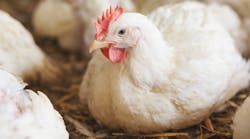Poultry Delivers Profits for Sanderson Farms
With poultry facilities scattered across the southeastern United States and Texas, Sanderson Farms Inc. is smack dab in the heart of hurricane territory, and the 2018 storm season has bruised the Laurel, Miss.-based producer.
Hurricanes Florence and Michael both made their presence felt, particularly in North Carolina, where Sanderson Farms lost 2 million chickens, and in Georgia, where operations shut down for a few days.
Weather events are going to happen, given the company’s geographic distribution, says CEO Joe F. Sanderson Jr. It’s how you react to those adverse events that matter.
“We have to be patient and get through it, take care of our growers, take care of our employees, take care of our customers,” Sanderson says. “We employed some lessons we learned in [Hurricane] Katrina to North Carolina and did our best to prepare. But when you get 40 inches of rain, you can’t do anything about that.”
That said, hurricanes aren’t the only challenge Sanderson Farms has encountered over the years. There has been bird flu, recessions, droughts, high grain costs and more.
Nevertheless, Sanderson Farms has shown remarkable resiliency in the face of challenge, and in 2018 it staged a return appearance on the IndustryWeek 50 Best US Manufacturers, an annual ranking of top U.S. public manufacturing companies based on six financial performance measures over a three-year period. Sanderson ranks No. 6 on the 2018 ranking, up from the ninth position the previous year.
The keys to the company’s resiliency and consistent performance? One, it recognizes the industry’s cyclical nature and doesn’t over-react to its ups or downs, and two, it keeps managers focused on what they do best, regardless of circumstances.
“Things occur, events or cycles. Our industry is used to facing that,” Sanderson says. “We want our managers not to pay any attention to that. We want them to focus on growing chickens, or processing chickens or selling chickens. They don’t need to be distracted by avian influenza, or an export ban or overproduction [or a] poor pricing environment. That is something they cannot control. They cannot do anything about that.”
Growing More Chicken Facilities
While the managers are focused on growing chickens, Sanderson Farms CEO has been focused, at least in part, on growing the company. What began in the 1940s as a family-run Purina feed and seed store has grown into a 15,000 workforce-strong integrated chicken business. In 2017 Sanderson Farms reported revenue of $3.34 billion. In 2004, by comparison, the company’s revenue was $1.1 billion and its employees numbered 8,300. (Its 2004 numbers helped put Sanderson Farms on the 2005 IW 50 Best list.)
It’s still growing. The company’s newest poultry complex is under construction in Tyler, Texas, and operations are anticipated to begin in the first calendar quarter of 2019. More than 1,000 team members will be employed at those operations.
Including Tyler, Sanderson Farms will have opened three complexes in six years, and it is no secret that the company is looking for a site on which to build another poultry complex.
Yet the CEO says the growth plans do not reflect a desire by the company to be the biggest.
“We never, ever and still do not today, want to be a big company and never did,” Sanderson says. “It was never our goal to be big or bigger; that is never a goal. We have always tried to increase our earnings for our shareholders and that is the only reason we have built new complexes--to increase our volume, to increase earnings per share.”
“Our responsibility to our shareholders, our obligation to our shareholders, tells us that we will continue, we must continue, to grow the company.”
And that means growing chickens, processing chickens and selling chickens.






